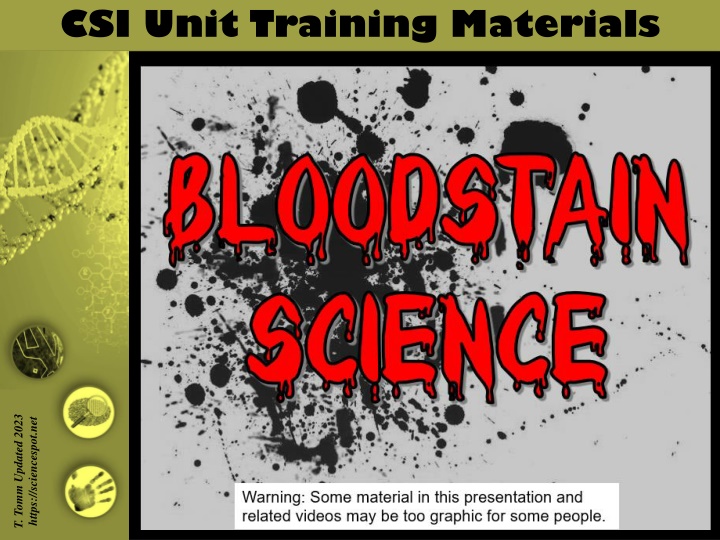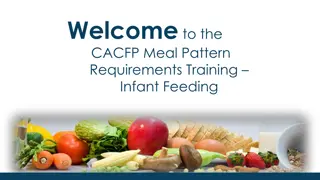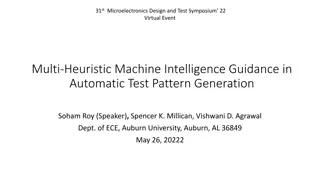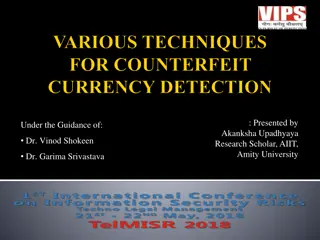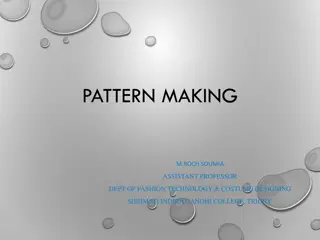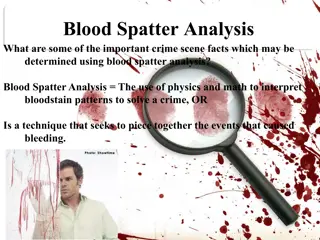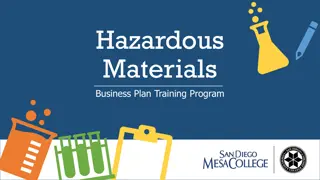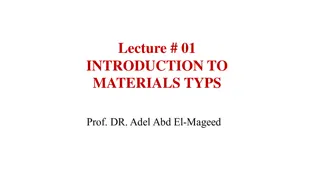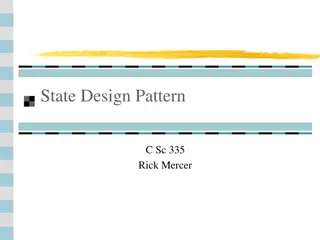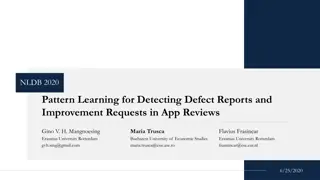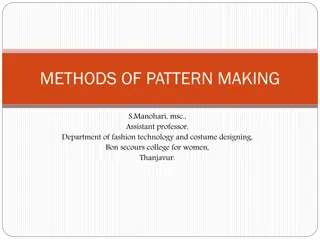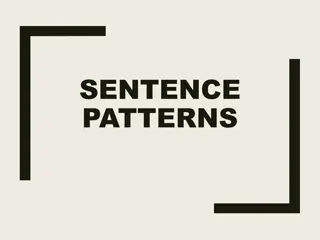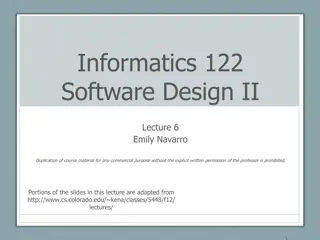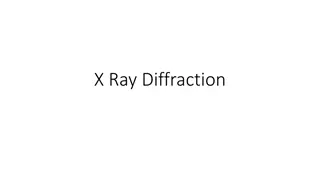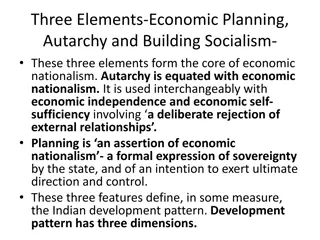Bloodstain Pattern Analysis: Training Materials and Techniques
Explore the fundamentals of bloodstain pattern analysis through interactive training materials covering topics such as BPA representation, types of blood patterns, droplet analysis, and more. Discover how investigators learn crucial details from blood spatter, including types of injuries, weapon information, and victim-suspect movements. Learn about detecting blood evidence at crime scenes using light sources and blood reagent tests. Dive into this comprehensive guide to enhance your understanding of forensic investigation techniques.
Download Presentation

Please find below an Image/Link to download the presentation.
The content on the website is provided AS IS for your information and personal use only. It may not be sold, licensed, or shared on other websites without obtaining consent from the author.If you encounter any issues during the download, it is possible that the publisher has removed the file from their server.
You are allowed to download the files provided on this website for personal or commercial use, subject to the condition that they are used lawfully. All files are the property of their respective owners.
The content on the website is provided AS IS for your information and personal use only. It may not be sold, licensed, or shared on other websites without obtaining consent from the author.
E N D
Presentation Transcript
CSI Unit Training Materials T. Tomm Updated 2023 https://sciencespot.net
Part A: Watch the Blood Spatter 101 video to help you complete this section. Bloodstain Pattern Analysis 1. What does BPA represent? 2. What are the three types of blood patterns? PASSIVE _____________ (or drip) stains occurs when gravity pulls blood downward to the floor or surface. They tend to be round and fat without tails. TRANSFER ______________ stains occurs when a bloody object comes in contact with another object or surface; appears as smears or stripes SPATTER IMPACT _______________ (or ___________) patterns occur when a force is applied to a blood object or pool and are classified as high, medium, or low velocity.
3. What can the shape and size of a droplet tell us? The angle of impact and the speed the droplet was traveling. Examine the blood spatter samples on your table. What do you observe?
Part B: Watch the BLOOD SPATTER BASICS video to help you complete this section. MOCK ANIMAL 1. The trainers created _________ scenes using ___________ blood to help police officers learn how to investigate crime scenes with blood evidence. 2. The height of the drop as well as the speed at which it is traveling affect the ________ and _________ of the blood droplets. SIZE SHAPE 3. True or False? ____ Blood evidence follows a definite pattern that can be applied to every crime scene. ____ Popular television shows, such as CSI Miami, are an accurate representation of how investigators analyze real crime scenes. ____ Blood evidence is easy to analyze and always tells investigators who is responsible for the crime. 4. The trainer reminds the investigators that what they can't ________, they can't _____ in a case or court of law. SAY F F F PROVE
Part C: What else can an investigator learn from the analysis of a blood spatter? TYPE OF INJURY- Blunt force, sharp force, gunshot, etc. WEAPON - Type and velocity WOUNDS Number of blows or the order in which they were inflicted POSITIONS and MOVEMENTS of the victim and suspect during the attack https://www.youtube.com/watch?v=I0-nIsw1LXU Source: http://science.howstuffworks.com/bloodstain-pattern-analysis1.htm
Part D: How is blood evidence detected at a crime scene? Light Source Investigators will first examine the crime scene to look for areas that may contain blood. They may use high-intensity light or UV lights to help them find traces of blood as well as other bodily fluids that are not visible under normal lighting conditions. Blood Reagent Tests These tests, referred to as presumptive tests, are used to detect blood at crime scenes based upon the properties of hemoglobin in the blood. Further tests at the crime lab can determine if it is human blood or not. Kastle-Meyer Test Video Examples: Phenolphthalein is a chemical that is still utilized today and is usually referred to as the Kastle-Meyer test and produces a pink color when it reacts with hemoglobin. HemaStix is a strip that tetramethylbenzidine (TMB) and will produce a green or blue- green color with the presence of hemoglobin. has been coated with HemaStix
Luminol This chemical is used by crime scene investigators to locate traces of blood, even if it has been cleaned or removed. Investigators spray a luminol solution is throughout the area under investigation and look for reactions with the iron present in blood, which causes a blue luminescence. One problem is that other substances also react, such as some metals, paints, cleaning products, and plant materials. Another problem is that the chemical reaction can destroy other evidence in the crime scene. Luminol Reaction Fluorescein This chemical is also capable of detecting latent or old blood, similar to luminol. It is ideal for fine stains or smears found throughout a crime scene. After the solution has been sprayed onto the substance or area suspected to contain blood, a UV light and goggles are used to detect any illuminated areas, which appear greenish-white if blood is present. It may also react to many of the same things as luminol (copper and bleach). Fluorescein Reaction in UV Light LCV or Leuco Crystal Violet, is one type of chemical process that is used for blood enhancement. Using this test helps to make the blood evidence more visible so it can be photographed and analyzed.
Part E: Bloodstain Pattern Analysis Terms Bloodstains created from the application of force to the area where the blood originated. SPATTER ORIGIN/ SOURCE The place from where the blood spatter came from or originated. Small drops of blood that break off from the parent spatter SATELLITE SPINES The pointed edges of a stain that radiate out from the spatter The droplet from which a satellite spatter originates. PARENT DROP
Part F: Blood Spatter Labs This can be messy! Be very careful to keep the blood on the paper and not on yourself, the table, or floor. Hold you hand as steady as possible when making the drops. Brace your wrist against the meter stick to help you. Get a pair of goggles and an apron. Sit quietly until we are ready to continue! If you make a mess or goof up a drop, grab a paper towel and wipe it up immediately!
Getting ready 1. Divide the paper into THREE sections. 30 S 2. Label one side with 30 S for 30 cm and SINGLE droplet. 90 S 3. Label the other side with 60 S for 60 cm and SINGLE droplet. 60 S 4. Label the middle with 90 S for 90 cm and SINGLE droplet.
Lab #1: SINGLE DROPS FOR EACH HEIGHT: X - Hold the dropper bottle upside down (& away from the ruler) so that the BOTTOM of it is the correct height from the table and blood won t get on the meterstick. - GENTLY squeeze the bottle so that ONE drop of blood is released and lands on your paper. Hold the bottle away from the meterstick Complete THREE good drops at each height. If you make a mess or goof up a drop, grab a paper towel and wipe it up immediately!
Lab 1: SINGLE DROPS The answers are What did you notice about the droplets (size, shape, & spines) as you increased the height of the drop? Explain using the terms height, diameter, and spines in your answer. WIDER The higher the height of the drop, the _________ the diameter of the parent drop and the ___________ the spines become. LONGER Quick Question: Which of the three blood droplets shown would have been created by a wound in the lower part of the leg? Why? The smallest diameter would be the from a lower height.
Lab #2: MULTIPLE DROPS Directions: 30M 90M 60M You are going to repeat the process from Lab 1 - same labels, same process. X You need to have TWO droplets in the SAME SPOT. If you miss, wipe it off with a towel and try again. Try THREE TIMES from THREE HEIGHTS 30 cm, 60 cm, and 90 cm with the simulated blood. Hold the bottle away from the meterstick, but brace your hand so it doesn t move. If you make a mess or mess up a drop, grab a paper towel and clean it up immediately!
DONE with Lab #2? Fold up your blood spatter paper and throw away. Put metersticks and blood on front counter Wash your hands. Answer the questions for Lab #2 before class tomorrow.
Lab 2: MULTIPLE DROPS The answers are What did you notice about the droplets (size, shape, & spines) as you increased the height of the drop? Explain using the terms height, diameter, spines, and satellites in your answer. WIDER The more droplets that land in the same place, the ___________ the diameter of the spatter pattern and _________ satellites appear that are _______-shaped with some with _________. OVAL MORE SPINES How do your results from Lab 2 compare to Lab 1? SATELLITE The single drops from Lab 1 did not have _____________ spatter and the spines tended to be ___________. SHORTER
Lab #3: MOTION DROPS We are going to walk at different rates (slow, medium, and fast) along a strip of paper and observe the changes in the spatter. Some of you will have a marker so you can help label the spatter. Use S for slow, M for medium, and F for fast. Answer the questions for Lab #3 before class tomorrow.
Lab 3: MOTION DROPS The answers are What did you notice about the droplets (size, shape, & spines) as you increased the walking speed? Explain using the terms speed, shape (round/oval), distance, and spines. SLOWER The __________ a person is moving the more-rounded the droplets with spines on all sides. The droplets will also be ________ _____________. CLOSER TOGETHER INCREASES OVAL As a person s speed _____________, the droplets will be further apart with an _______ shape and spines mostly on _____ side. ONE
Lab #4: ANGLE OF IMPACT Directions: Divide a piece of copy paper into three columns and label with the angle for each droplet - 25o, 45o, 60o. Place the paper on the clip board and align the clipboard with the 25o line. Hold the bottle of blood at a height of 50 centimeters from the top of the paper. GENTLY squeeze the bottle so that a SINGLE drop of blood is released and lands on the paper. Repeat two more times at this angle. Try the test again, but use 45o and 60o
Lab 4: ANGLE OF IMPACTThe answers are How does the ANGLE OF IMPACT affect the blood spatter? Explain using the terms angle, shape, length, & tails. The greater the angle with the table (25o the droplet and more ________-shaped it will be with _________ tails. 60o), the ___________ LONGER LONGER OVAL The droplets that form from angles close to 90o with the table tend to be __________-shaped without __________. ROUND Has spines on all sides length depends on the height of the drop TAILS What does the tail tell us? Indicates the direction of movement after the droplet hits the surface
Remember the blood spatter samples on your table at the start of this lesson. Examine them again. Are you able to explain how each of the patterns was likely created? How did your observations change after completing the labs?
1. What forces are acting on a blood droplet as it falls? 2. If you have a blood droplet like this one, what does it tell you? Explain. QUICK QUESTIONS 3. If you find a trail of blood with droplets that are round and close together with small spines, what could this mean? 4. How do Newton s Laws of Motion apply to blood spatter?
